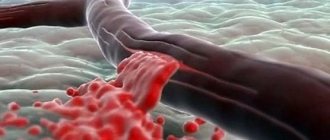Home » Useful Information
Every cat owner knows that a tiny meowing lump, brought into the house, very quickly becomes a full member of the family. Pets give us their unselfish love and affection, and in return we treat them as members of our household, surrounding them with attention and care. But cats are so curious, restless and adventurous that it is almost impossible to protect them from all potential dangers. And these graceful creatures - just like people - sometimes get sick. And a dangerous manifestation of an injury or serious illness in an animal can be internal bleeding.
- 2 What types of bleeding can occur?
2.1 Table: classification of bleeding
- 3.1 Table: external signs of obvious internal bleeding
- 5.1 How the doctor can help
What is bleeding and why is it dangerous for a cat?
A cat's heart pumps a certain amount of blood through its circulatory system. Passing through the vessels, blood supplies the tissues and organs of the animal with the necessary amount of oxygen, participates in local metabolic processes and performs a protective function, fighting local inflammation.
If for any reason the integrity of the walls of blood vessels is compromised, some of the blood will be able to leave its usual route. The process of blood loss from the bloodstream due to damage to the walls of blood vessels is called bleeding.
When bleeding, part of the blood leaves the bloodstream through damage in the walls of blood vessels
If the bleeding is minor and does not recur regularly, the body of a healthy animal is able to cope with it without outside help. In this case, a protective mechanism is triggered: the vessels reflexively contract, and clots of coagulated blood form at the sites of their damage, stopping blood loss. The consequences of such bleeding are usually not dangerous for the cat.
But significant blood loss, which the body lacks its own strength to combat, poses a threat to the life of the animal. As a result of serious bleeding:
- the mechanics of blood circulation are disrupted;
- The blood vessels and heart are not filled enough;
- blood pressure drops;
- acute anemia develops (the number of red blood cells and the level of hemoglobin in the blood sharply decreases);
- the process of oxygen delivery to organs and tissues is disrupted;
- hypoxia (oxygen starvation) of tissues occurs;
- local metabolic processes are disrupted;
- cell death occurs and, as a consequence, the death of the entire organism.
Typically, a cat's death results from the loss of 2/3 to 3/4 of its total blood volume.
Key points
- Most of the causes of gastrointestinal bleeding are amenable to therapeutic correction, although in some cases surgical treatment is indicated.
- Gastrointestinal bleeding is an important cause of blood loss anemia in dogs and cats.
- The most common cause of gastrointestinal bleeding described in dogs and cats is ulceration (ulceration) of the gastrointestinal tract.
- the presence of hematomesis and melena allows one to suspect gastrointestinal bleeding, but these signs are not always observed.
- It is reasonable to use gastroprotectors until the cause of gastrointestinal bleeding is confirmed.
- If a patient has gastrointestinal bleeding, the patient’s hemodynamic (cardiovascular) condition should be examined. If there are signs of shock, immediately begin intensive correction of the condition.
- In cats, the typical cause of ulceration is a neoplastic process.
- In dogs, thrombocytopenia should not be ignored as a cause of gastrointestinal bleeding.
- A common cause of ulceration in dogs is the use of NSAIDs and liver disease.
What kind of bleeding can there be?
Although the cause of blood loss is always a violation of the integrity of the vessel wall, the bleeding itself can be very different.
Table: classification of bleeding
| Classification sign | Types of bleeding |
| Type of damaged vessel |
|
| Time of bleeding |
|
| Direction of blood flow |
|
With external bleeding, blood flows freely outward
At the same time, no matter how the blood loss occurs (drop by drop, in a thin stream or in a pulsating fountain), external bleeding is almost always clearly visible, while internal bleeding is never visible. And this makes internal bleeding especially dangerous.
Kinds
It is important to see the difference between the two concepts “pulmonary hemorrhage” and “hemoptysis”. The latter is less dangerous, it is characterized by a lower volume and rate of blood release, but it can often precede bleeding. Therefore, the importance of its treatment is undeniable.
The classification, which has been used since 1990, distinguishes three degrees of bleeding:
- The first stage is daily blood loss from 50 to 100 ml;
- The second stage is daily blood loss from 100 to 500 ml;
- The third stage is daily blood loss of more than 500 ml.
The condition of heavy bleeding, which occurs simultaneously or over a short period, is extremely dangerous. So, in a severe form of the syndrome, the immediate blood loss can be more than 100 ml.
The difference between “hemoptysis” and “pulmonary hemorrhage” is also important because the first does not frighten the oncologist, he simply makes adjustments to the treatment, while the second requires urgent help, often resuscitation.
Overt and hidden internal bleeding
Although internal bleeding itself cannot be seen with the naked eye, some types of it are still characterized by certain external manifestations. This type of bleeding is called overt internal bleeding.
Table: external signs of obvious internal bleeding
| Type of obvious internal bleeding | External signs |
| Bleeding in the esophagus | Vomiting blood (blood in the vomit is scarlet) |
| Stomach bleeding | Coagulated dark red or brown blood (“coffee grounds”) in vomit |
| Intestinal bleeding | Vomiting "coffee grounds" (for bleeding in the small intestine) and/or stools that are dark bloody or resemble "coffee grounds" (for bleeding in the lower intestine) |
| Pulmonary hemorrhage | Cough with frothy, bloody sputum |
| Uterine bleeding | Bloody discharge from the loop |
| Kidney bleeding | Blood in any urine |
Any caring owner will definitely pay attention to such alarming manifestations, which means that the animal’s chances of not bleeding to death are quite high. The situation is much worse with so-called hidden internal bleeding.
Hidden internal bleeding
Hidden internal bleeding does not have any immediate manifestations visible to the eye. This is because they occur inside body cavities (such as the abdominal cavity) or organs (such as the spleen) that have no communication with the outside environment. However, such bleeding has certain indirect signs:
- dyspnea;
- pallor of the mucous membranes;
- sudden fatigue;
- lack of appetite;
- weight loss;
- apathy and drowsiness;
- rapidly increasing abdominal volume;
- bruises under the skin.
Pale mucous membranes of the animal (best seen on the inside of the lips and gums) may be a sign of hidden internal bleeding
And the owner must be truly attentive to his pet in order to recognize warning signs in time and help the animal save its life.
Good to know
- Esophagoscopy in dogs and cats
- Protein wasting intestinal disease in dogs. Enteropathy in dogs
- Treatment of hyperlipidemia in dogs with Bezafibrate
- Vomiting, regurgitation in dogs and cats
- Small intestinal transient disorders
- Diseases of the anus and rectum in dogs and cats
- Cholangitis in cats. Identifying, diagnosing and treating cats with neutrophilic, bacterial, lymphocytic or chronic cholangitis
- Diarrhea in dogs and cats
- Hematemesis in dogs and cats
- What are the main causes of protein-losing enteropathy in dogs?
- Main causes of chronic colonic diarrhea in dogs and cats
- How to distinguish chronic small intestinal diarrhea from large intestinal diarrhea?
- Causes of malabsorption in dogs
- Vomiting in cats and dogs
- Causes of acute diarrhea in dogs and cats
- Canine distemper in dogs (forms, diagnosis, symptoms, treatment, therapy)
- Canine exocrine pancreatic insufficiency
- Enteral nutrition for dogs and cats
- Protein-losing enteropathy. Protein enteropathy in dogs
- Lymphocytic cholangitis in cats
- Acute pancreatitis in dogs and cats
- Gastric volvulus in dogs
- Fat metabolism and hyperlipidemia in dogs
Causes of internal bleeding in cats
So, internal bleeding is a multifaceted thing and very dangerous for the health and even the life of a furry pet. But why might it arise?
The causes of internal bleeding in cats are usually divided into traumatic and non-traumatic. And it is worth noting that traumatic causes lead by a significant margin. A blow, a fall from a height, compression - all this can lead to mechanical damage to the integrity of the walls of blood vessels and lead to traumatic internal bleeding.
On the other hand, the presence of diseases in an animal such as atherosclerosis, purulent inflammation, or an oncological tumor can cause pathology of the walls of blood vessels and cause non-traumatic internal bleeding.
A special place in the list of non-traumatic causes of internal bleeding in cats is coagulopathy - a blood clotting disorder. This disorder is often a consequence of poisoning (for example, rat poison).
Finally, we need to mention hematomas. These localized collections of blood typically form initially due to traumatic vascular injury. But, having ruptured and begun to bleed, hematomas can cause non-traumatic internal bleeding.
Any injury - a blow, a fall from a height, squeezing - can cause internal traumatic bleeding in a cat.
How does the disease progress? Forms and their characteristics
Peptic ulcer disease occurs in cats of various breeds and ages. It is not inherited and is not contagious. The disease occurs in pets in different forms:
- Simple (acute). Characterized by sudden attacks and accompanied by severe pain, which intensifies when pressing on the abdominal area.
- Progressive (chronic). Usually asymptomatic, so the owner in the initial stages does not notice any changes in the animal’s appetite, appearance and behavior.
Both forms of peptic ulcer require professional treatment.
When is it time to go to the vet?
The main rule of any cat owner: no panic! Anything can happen in a cat’s life, and you shouldn’t rush around hysterically when you notice a drop of blood on your pet’s paw. But there are things that definitely require a visit to the veterinarian:
- the animal began to bleed blood from its natural orifices;
- The cat's feces are dark red;
- the pet vomits blood;
- blood is visible in the animal's urine;
- one or both eyes of the pet are red;
- The cat has hematomas (voluminous, elastic swelling) under the skin on the paws (leg, thigh, shoulder), on the outer ear, on the oral mucosa or skin.
In these cases, there is no point in delaying a trip to the veterinary clinic. However, before meeting with a doctor, there are some things you can do for your pet yourself:
- minimize stress in the animal by providing it with warmth and peace;
- move the cat very carefully (especially if there is a suspicion of injury);
- apply a cold compress to the suspected area of injury;
- Do not give your pet water, food, medication, or try to administer an enema.
And most importantly, remember: you cannot cope with internal bleeding on your own! In these cases, all hope lies with the veterinarian.
At the slightest suspicion of internal bleeding in a cat, a visit to the veterinarian is inevitable.
How can the doctor help?
The first task of a specialist is to conduct a competent diagnosis. After all, for example, the visible manifestations of gastric and intestinal bleeding are very similar, and in really serious cases, the life of your pet depends on the speed of making a diagnosis and taking adequate measures.
Typically diagnosis includes the following steps:
- taking an anamnesis (you will have to tell the whole medical history, any details are very important);
- physical examination of the animal;
- X-ray of the abdominal cavity (allows us to detect the presence of free fluid in the abdominal cavity, as well as massive formations such as tumors and hematomas);
- puncture of the abdomen using a needle and syringe (to obtain a sample of fluid for analysis) and analysis of the resulting fluid;
- blood tests (clinical analysis shows the presence of anemia, biochemical analysis determines the presence of damage to internal organs, coagulogram shows a blood clotting disorder);
- ultrasound examination of the abdominal cavity (allows us to detect the presence of tumors in the abdominal cavity);
- CT or MRI (allows you to visualize neoplasms that are inaccessible to ultrasound).
The physical (primary) examination of the animal consists of mandatory steps, performed in any order. This is mainly a visual examination and palpation (palpation), in which the specialist uses his senses and uses vision, touch, smell and hearing.
Immediately after diagnosis, the veterinarian prescribes treatment, which directly depends on the cause of the bleeding and the general condition of the animal. The most typical stages of such treatment are the following:
- abdominal puncture (pumping out excess fluid that interferes with normal breathing);
- intravenous administration of saline and plasma preparations to maintain the required blood pressure;
- blood transfusion (blood transfusion) with significant blood loss;
- an increase in intra-abdominal pressure to help stop bleeding (using compression bandages);
- oxygen therapy;
- anesthesia;
- administration of vitamin K (for coagulopathy);
- emergency surgery if treatment does not give results (does not stop bleeding) or in cases of neoplasms.
The result of the operation can be both the actual stopping of internal bleeding and the removal of an organ damaged by injury or an oncological process that caused blood loss. The postoperative period takes place in a hospital setting, where the animal receives the necessary antibacterial therapy and transfusions of plasma and blood preparations.
Features of the diet for ulcers
Therapy for peptic ulcer disease in a cat is associated with changes in its diet and nutrition. It is recommended to feed your pet 4-5 times a day, but in small portions. Make sure that food is at room temperature: too hot or cold foods can cause an exacerbation of the disease.
Recommended food:
- liquid rice porridge,
- other slimy porridges (for example, oatmeal),
- weak meat broths (chicken, turkey),
- dairy and fermented milk products (for example, kefir, low-fat cottage cheese, cream),
- boiled eggs,
- boiled vegetables (carrots, broccoli).
It is forbidden to give cheap dry food, canned food, or food from the table. If you still have questions related to your cat's nutrition, be sure to consult your veterinarian!
Treatment
In the treatment of the syndrome, therapeutic methods, hemostasis, and surgical operations are applicable.
Therapy is prescribed for the syndrome classified as the first two stages.
Aspiration is necessary to remove blood from the tracheal lumen. If we are talking about asphyxia, then urgent intubation, blood suction and artificial ventilation of the lungs are necessary.
Among the medications, hemostatic drugs and antihypertensive drugs are prescribed.
If therapeutic methods do not give a positive result, the syndrome is stopped through local endoscopic hemostasis.
As a rule, these methods help to stop the development of the syndrome for some time.
Palliative surgery is used in cases where it is impossible to perform radical surgery.
As for radical operations, they are aimed at partial resection of the lung, for example, marginal resection or removal of the entire organ.
Symptoms
Medical practice shows that the syndrome is usually preceded by a severe cough. At first it is dry, then mucous sputum and blood admixtures are observed. As we have already said, the blood can be scarlet or in the form of clots.
In some cases, the precursors of the syndrome are:
- A tickling or gurgling sensation in the throat;
- Burning in the chest.
The general condition of the patient largely depends on how the blood loss is expressed. It could be:
- Fright;
- State of sudden loss of strength;
- Pallor;
- Sweating;
- Reduced blood pressure;
- Cardiopalmus;
- Feeling dizzy;
- Shortness of breath, etc.
If the syndrome is classified as profuse, the following may occur:
Coughing up bloody mucus
- State of fainting;
- Vomit;
- Convulsive state;
- Visual impairment;
- Asphyxia.











